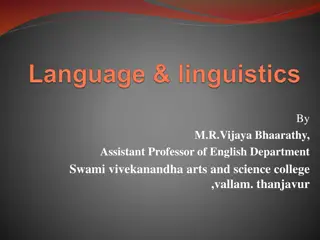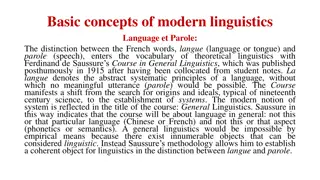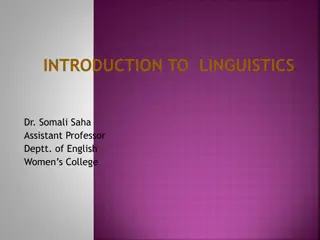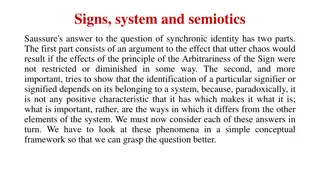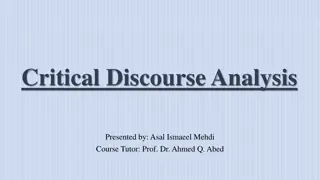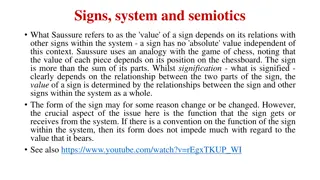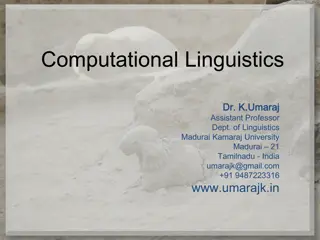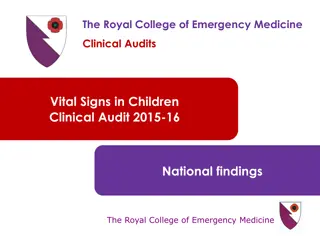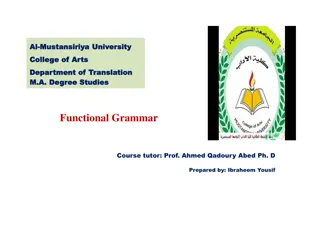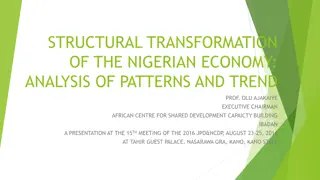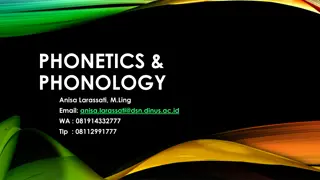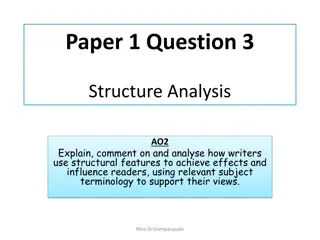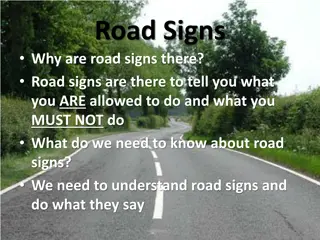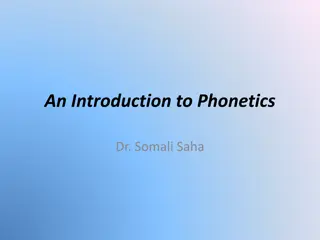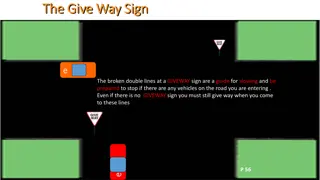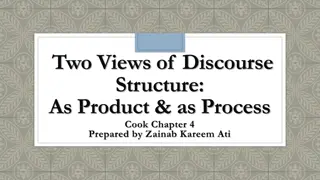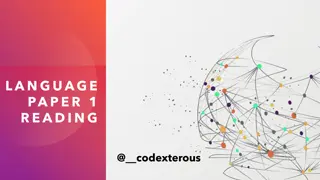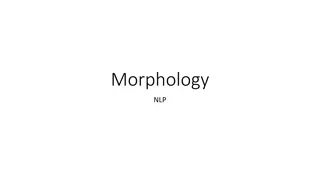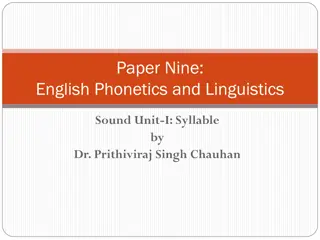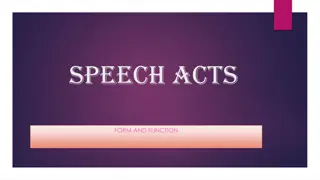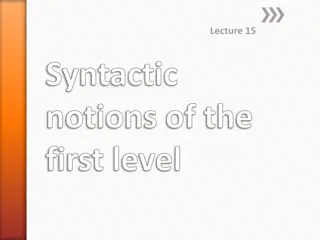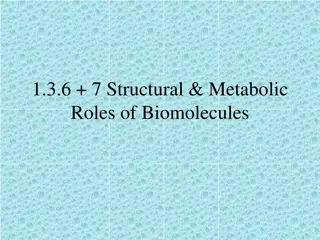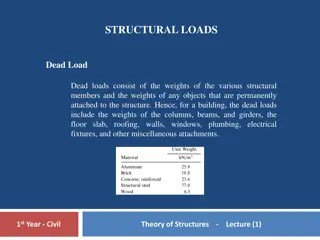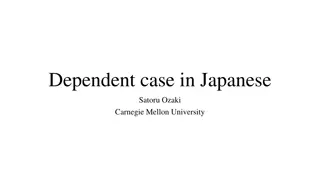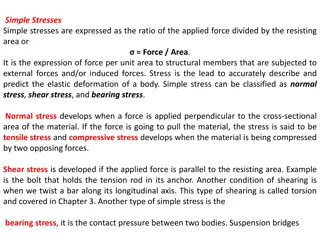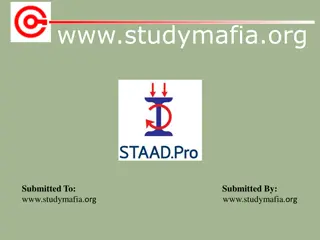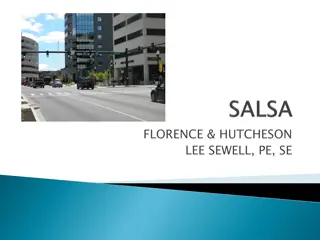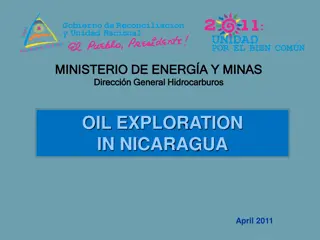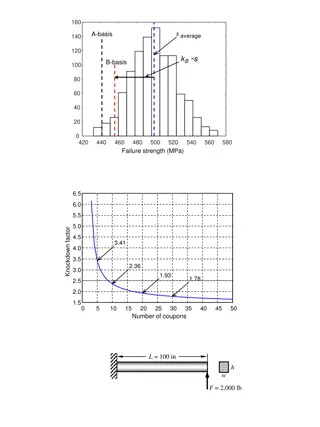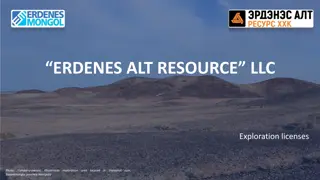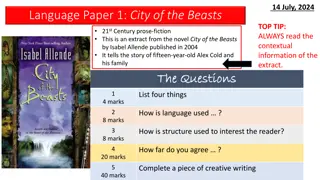Understanding Structural Linguistics: An Exploration of Language and Signs
Delve into the intricate world of structural linguistics through an in-depth analysis of language components, linguistic signs, and the relationship between language and linguistics. Explore the concepts of syntagmatic vs. paradigmatic relations, linguistic signs as associations of sound and meaning, and the acquisition of language as a verbal behavior. Engage with the fundamental aspects of linguistics and gain insights into the structural system of signs that form the basis of human communication.
- Structural Linguistics
- Language Components
- Linguistic Signs
- Syntagmatic Relations
- Paradigmatic Relations
Download Presentation

Please find below an Image/Link to download the presentation.
The content on the website is provided AS IS for your information and personal use only. It may not be sold, licensed, or shared on other websites without obtaining consent from the author. Download presentation by click this link. If you encounter any issues during the download, it is possible that the publisher has removed the file from their server.
E N D
Presentation Transcript
Course Title: Structure of English II Course Code: MTLa 321 Instructor: Shegaw Wedaj (PhD)
Unit One: Introduction 1. What is Language? Structural Linguistics Generative Linguistics components of language- Sound Component -Grammar component -Meaning component
2. What is Linguistics? branches of linguistics -phonetics and phonology -morphology and syntax -semantics and pragmatics
3. What is the relation between language and linguistics?
Structural Linguistics (1857 1913) 1916 Language = structural system of signs
Structural linguistics Cntd. What is Language? -Language-a structural system of signs; -Sign =linguistic element -Structure =product of hierarchical combination of signs; -System: Syntagmatic vs paradigmatic relation
Structural linguistics Cntd. Language as Sign; What is a linguistic sign? A linguistic sign is the association of a sound and a meaning. Dyadic View of Sign = Language as an arbitrary; English= dog Spanish= un perro German= ein hund French= le chien
Triadic view of sign (Peirces model) Concept Refers S Symbolizes [tri] Symbol Causal Relation Causal Relation Semiotic Triangle Sign=tree .Arbitrary Relation Referent 8
Language as a relational system of signs: Paradigmatic vs. sytagmatic: Substitution vs. Co-occurrence: Same vs. Different categories
Structural linguistics Cntd 2. What aspect of Language is acquired? Learning is knowing a new behavior and changing the behavior. Language is a verbal behavior. Learning a new structure of sign (word) is learning a new behavior and changing the previous behavior. Learning is knowing a new sign/structural system.
Structural linguistics Cntd. 3. How are the structural system of signs acquired? Claim: Learning happens when a correct response is demonstrated following the presentation of a stimulus; Assumption: Organisms can be conditioned to respond in desired ways, given the correct degree of reinforcement.
Structural linguistics Cntd. Pavlov s experiment
Structural linguistics Cntd. Pavlov established stimulus-response pattern =the sound of the bell is the stimulus and salivation is the response; Psychologists called it classical conditioning;
Structural linguistics Cntd. Scholars expanded it in to operant conditioning Skinner -stimulus-response-reinforcement; -response becomes habit in the future; Watson and Skinner applied the concept in SLA; The language learner is an organism whose behavior is conditioned; The behavior/language is verbal behavior;
Structural linguistics Cntd. Language is analyzed into smaller units (signs) (sounds-feature/words-morphemes/phrases- words/sentences-phrases) contrasted with another (paradigmatic) (features/sounds/morphemes/words/phrases/sentences) and added up to form the whole (syntagmatic). (features-sounds-morphemes-words-phrases-sentences)
Generative Linguistics (1928-) 1957
Generative Linguistics Contd. 1. What is language for Generativists? Language -a set of innate rules. competence vs. performance. Chomsky adds a cognitive dimension to the linguistic system; Competence linguistic system + native speaker's knowledge;
Generative Linguistics Contd. Poverty of the Stimulus The arguments for Generative linguistics start with-poverty of the stimulus argument: -States that children are not exposed to rich enough data within their linguistic environment to acquire every feature of their language. -However, children have come to produce new, complex and rich enough structures of their language; -There must be human innate knowledge of language (UG)
Generative Linguistics Contd. Claim: speaker-hearers competence in their native language is an innate knowledge that the human species is genetically endowed with. Assumption: human mind consists of different compartments one of which is the language faculty/ Language Faculty/LAD LAD.
in the faculty/LAD there is universal grammar (UG); UG---Principles and parameters are innate/common for all; Principles explain similarities across lgs; parameters explain d/ces among lgs;
Principles -Phrase Structure =the phrases of all languages consist of heads and possible complements; parameter- Head initial and Head final = Some languages are head initial and some are head final; Eg. English =head + complement -The man [killed (head) the lion (com)]VP. Amharic =Complement + head- - [ (com) (head)]VP
Principle -Pronoun Subject = Pronouns of all languages function as subjects; Parameter- Pro-drop and non pro-drop =some languages are pro-drop and some are non pro-drop; Eg. -English- He killed the lion. (non pro-drop) -Amharic- ___ :: (Pro-drop )
2. What aspect of language is acquired? What is acquired/learnt? =rules of the target language; whatare the rules of a target language?=parameter settings (head first/head final) principles and parameter options are innate; parametersettings are triggered by input/learnt. Languages have few rules for basic sentence structures (PSRs), and a limited set of transformational rules (TRs) ( movement, insertion) for deriving other structures.
3. How do children acquire language? through cognitive process =finite rules/parametric options are triggered by limited input. Acquisition of a specific language -a process of selecting among the limited parametric options that matches the linguistic input.
Grammar/Language system Phonology Lexicon Syntactic Semantic It is obvious that words are made up of sounds (or at least that they contain sounds) and that sentences are made of words, and sentences must be meaningful.
3. Semantic Component 4. Phonological Component Sem. Rep. 1. Lexicon Syntactic Represen + 2. Syntax Pho. Rep.
Grammatical Components of Language Morphology and Syntax 1 What is morphology? -THE STRUCTURE OF WORDS -the formation of words eg. Workers is formed from --work+er+s; -analysis of words eg. Workers is analyzed in to --work-er-s;
1.1 Concepts of Words Lexicon/lexeme/word Lexicon-mental dictionary Lexeme- Basic abstract unit of a wordthat could be realized in different grammatical forms; eg. write in writes, wrote, written. A lexeme may also be part of another lexeme, e.g. writer, is a lexeme which is part of the lexeme write;
Word- the physical realization of lexemes in contexts of use; Eg. Write =They write/he writes/wrote/is writing/has written/ =Write/writes/wrote/written/writing/writer/wri ters =WRITE/WRITER
1.2 Word Classes =Lexical/content/open vs. Grammatical/function/closed words Eg. Book/go/the/of/and/quickly/tall Open word classes: Closed word classes: The focus of morphology: Open word classes Classification of open word classes:
1.3 Criteria for Determining word category/class/parts of speech Semantics-N-name entity/object/, V-action/sense, Adj-describe nouns, Adv-describe verbs Morphology-N-pl/possessive, V-tense, Adj-comp/sup, Adv-ly Syntax/distribution-N-takes Art/Adj, V-aux, Adj/Adv-degree words
1.4 Types of words =Simple/compound/complex words Eg. Teach/blackboard/blackboards/teachers/tea ching/reexaminers Simple words: Complex words: Naming parts of complex words:
1.5 The Concepts of Morpheme Types of Morphemes =Status: Free vs. Bound =Function: Derivational vs. Inflectional =Position: prefix/sufix/infix/circumfix
1.6 The difference between Inflectional and Derivational Morphemes 1. Productivity Productivity=derivationals are less productive than inflectionals; Eg. the derivational morpheme=en goes with weak-en, deep-en, white-en, but not with*yellow-en, *ugly-en, *slow-en The inflectional morpheme=er-goes with relatively many adjectives to make comparative
2. Order of occurrence=first/last -derivationals occur first, but inflectionals last; Eg. reexaminers 3. Affixation property=prefix/suffix Eg. reexaminers 4. Requirement in syntax= inflectionals are required, but derivationals are not required by syntax. Eg. They are happy/unhappy //He is happy/unhappy They work //He works 5. Role in changing meaning and/or word class=change/no change Eg. workers
Exercise 1: look at the following words. a. reactivated b. Hospitalization c. Fingers d. Misleadingly e. Discouraged 1. Identify the morphemes 2. Label each of them as derivational or inflectional morpheme
1.7 The difference between Morpheme /morph /allomorph Morpheme (meaning)-the smallest meaningful unit of a language; Morph (form)-a physical representation of a morpheme in a language; Allomorph (other form)- variants/realizations/manifestations of a morpheme;
1.8 The relationship between Morpheme and morph 1. Allomorphic =one meaning but different forms Eg. a. indefinite article: an orange/ a building b. plural morpheme: cat-s [s] { dog-s [z] { judg-es [iz] [z] after voiced consonants and vowels: beds, knees [s] after voiceless consonants: tulips, parents [Iz] after sibilants: horses, bushes c. past tense [d] after voiced consonants and vowels: rubbed, judged, entered [t] after voiceless consonants: stopped, kicked, laughed [Id] after [t, d]: wanted, decided
2. Homomorphs =one form/ different meanings in different contexts Eg. Tall=tall-er/teach=teach-er 3. Portmanteau morph=one form/different meanings in the same context Eg. He teaches=s/es=tense/person/number 4. Zero morph=there is meaning but no form/there is change in meaning but no change in form; Eg fish-sg=fish-pl/sheep-sg=sheep-pl /cut-pres=cut- past=cut-past parti
5. Suppletion =irregular' relation between the base and the new words. be = am/is/was/been/being/were/are go =went/gone good =better/best 6. Ablaut =Morpheme internal changes/the word changes internally English: sing, sang, sung, /man, men,/ goose geese
Allomorphic Conditions=causes for variation 1. Phonetic/phonological conditions= Allomorphic =pl/past/indefiniteness 2. Lexical/morphological conditions=ox- oxen/child-children 3. Grammatical conditions/caused by grammar change=Not very common in English Definiteness in Amharic=u in masculine/wa- in feminine
Determining allomorphs and morphemes 1. Complementary distributions=Allomorphs=work-t/mend- ed/clean-d 2. In contrastive distributions =Morphemes=work-s/work-ed
Determining the underlying form of the allomorphs Plural----------s] after voiced consonants and vowels ----------[z] after voiceless consonants -----------[iz] after sibilants 1. Which form is the underlying form?=wider distribution 2. what motivates the change?=ease of articulation
Exercise 2: Consider the following nouns in Zulu (a language in South Africa) umfazi married woman abafazi married women umfani boy abafani boys umzali parent abazali parents umfundisi teacher abafundisi teachers a. What is the morpheme meaning singular in Zulu? b. What is the morpheme meaning plural in Zulu? c. List the Zulu bases to which the singular and plural morphemes are attached, and give their meanings.
Look at the following data from Swahili: Swahili English Mtoto child watoto children mtu person watu persons kisu knife visu knives kikapu basket vikapu baskets 1. Identify the singular and plural morphemes. 2. Do the singular and plural morphemes have allomorphs? 3. If yes, what is context of the allomorphs?
2.1.3 The difference between Root /Base /Stem 1. Root the most basic morpheme of a word; it is the irreducible part of a word; -This means any morpheme, excluding affixes; Eg. Re-search-er-s=search is the root; =Number of Roots =Number of words in a given data (the words are not compound);
2. Base -an element, which is ready to take any affix that can be derivational or inflectional. Eg. Re-search-er-s=search is root and base for (re-)=research; Research is base for (-er)=researcher; Researcher is base for (-s)=researchers; =Number of Bases =number of affixes in a given word/data;
3. Stem -an element, which is ready to take an inflectional morpheme; Eg. Researcher is stem for (-s)=researchers; =Number of stem =number of inflectional affixes in a given data; =All roots are bases; =all stems are bases; =bases are stems only in the case of inflectional affixes;
Exercise: identify the roots, bases and stems in the following words; a. Workers b. unkindness c. reactivated
2.1.4 Hierarchical/Internal structure of words =the base and result of derivational morphemes; Lexicon =(kind, un-, -ness) Eg. Unkindness un- needs a base with Adj category Un- derives Adj word class with negative meaning -ness needs a base with an Adj word class -ness derives N word class;



